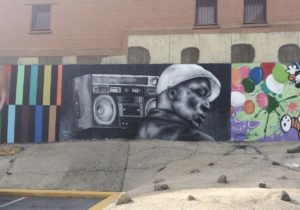John “SinXero” Beltran learned quickly that street artists from all corners of the earth know about the Bronx.
The 46-year-old Bronx native began inviting artists to paint legal street murals in the Bronx in 2012, and in 2014 founded a non-profit called TAG Public Arts Project. Since then, dozens of artists have painted for Beltran, a number of them foreign.
One, an Italian artist named Barlo, came to Beltran with a proposal to paint a giant, gold-outlined bird whose wings would be composed of images of feathers from species specific to the Bronx. Beltran had never heard of many of the birds, but the proposal confirmed his belief that artists from across the globe would be eager not only to paint in the Bronx, but also to delve into its history, culture, and even wildlife. The mural now stands on a wall on Ferris Place, in Westchester Square.
The borough’s tradition of creating iconic graffiti on building walls and subway cars in the ‘70s and ‘80s, and its role in the rise of hip hop have made it a desirable destination for street artists from around the world. Beltran, an abstract artist himself, has welcomed them with open arms. “When we do feature international artists,” Beltran said, “they feel proud being given the opportunity to be part of the history of the Bronx.”
Beltran’s latest mural project brought the French-born and London-based female street artist, Zabou, to a wall in a parking lot behind a Port Morris McDonald’s. Zabou painted a mural of the legendary Bronx-born emcee Grandmaster Flash holding a boombox and peering defiantly over his shoulder.
Zabou was recommended to Beltran through a mutual friend, but she still went through TAG’s selection process, in which artists submit a specific proposal to fill the space Beltran has acquired.
“When I saw the location of this spot,” Zabou said, “I kind of thought okay I need to look what’s happening here in this district, and if there’s any special features anything that would talk to the people directly.”
A self-described “huge hip hop fan,” Zabou knew immediately that she wanted to pay homage to the Bronx’s role in the rise of the genre. She settled on depicting the figure whom many consider its pioneer. Flash has also been gaining prominence in the past month among her friends in London, Zabou said, for his role in “The Get Down,” the Netflix series dramatizing the birth of hip hop in the Bronx.
Beltran said that both fellow artists and the Bronx community have given the mural “rave reviews.”
Chris Landy, 32, and his brother Raliekh, 27, who grew up in the area and frequent the McDonald’s near the painting, found the mural moving, and felt it fit in well with the surrounding area.
The elder Landy, a music producer, immediately recognized Flash, calling him “an integral part of the hip hop community.” The mural, he said, has the potential to impact people in different ways depending on their background and perspective. As a member of the music industry himself, Landy reasoned that if Flash “can make it, I know I can.”
Raliekh Landy was surprised to learn that the artist was French, and said that Zabou “must know about the culture” in the Bronx.
Audrey Connolly, a photographer who documents New York graffiti and street art, was excited not only by the presence of international artists in the Bronx, but also by the increasing international recognition Bronx street art is getting. “It’s about time that people in the rest of the world realized that the Bronx has heroes,” she said.
That realization, according to Beltran, is long overdue. He made clear that he, and the artists he invites, are not trying to make art in the Bronx more serious or legitimate. They are building on a long and proud history of artistic creation in the borough. “When people said, ‘we want to bring Fine Arts back to the Bronx,’” he said, they misunderstood that history. “There’s always been Fine Arts in the Bronx.”


